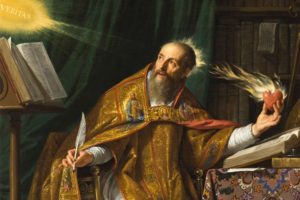By now virtually everyone with an internet connection has viewed Jefferson Bethke’s video Why I Hate Religion, But Love Jesus. What you may not have seen, however, is the Catholic response titled Why I Love Religion, And Love Jesus (below) performed by Fr. Claude “Dusty” Burns (aka Fr. Pontifex) and produced in short order by Spirit Juice Studios. On their website is the stated purpose: “to do a response from a Catholic perspective, in a spirit of love, but also with a spirit of passion to defend our Mother the Church. The things that are said are not meant to offend, but we do have to be direct about what we believe and what we stand for.”
Here is some back-story and a few observations that came to my mind after watching the video.
In an interview with The Catholic Beat, Rob Kaczmark of Spirit Juice (pronounced quickly, it sounds like “spiritus“) described his feeling when he and Sister Helen Burns first watched Bethke’s video. He writes: “We watched it together, and we were so upset. There are a lot of anti-Catholic videos out there, but I felt more attacked in this one than I have in ages. … Right away we knew [that the response] had to come from a priest and we only knew of two rapping priests: Fr. Pontifex and Fr. Stan [Fortuna, a Franciscan friar in New York].” It turned out that Fr. Claude was already hard at work on a Catholic version. Matching Bethke claim for claim, Claude wrote his reply late into Friday evening and again on Saturday morning while preparing for mass services at his parish, Holy Spirit. On Sunday, he found a church in which to record—Queen of All Saints Basilica in Chicago. Tuesday morning, before the sun rose, Fr. Claude left the rectory at 5 am for the five-hour drive northward from Evansville Indiana, followed by a five-hour taping. “The main reason we made it is not for publicity,” said Claude; “we just wanted it to be a video that defended our mother, the Church. We want people to know that institutional religion is not something to be feared, not something oppressive — it’s an exciting, living organism. The Church is the extension of Jesus Christ. We are the light of Jesus Christ in the world.”
First, how cool is it that there are rapping priests. If this is not the triumph of Vatican II, I don’t know what is. Second, I appreciate Fr. Claude’s demeanor. Note his opening statement, presumably aimed at Bethke, “You clearly have a heart for Jesus.” This is not the adversarial posture that you find among many Catholic apologists, or, worse still, some Protestant converts to Rome who then write books about their conversion (for the record, I would not put Frank Beckwith’s work in this category). I hear the voice of a pastor, one who is attempting to extend grace. But Fr. Claude is also truthful—“This had to be addressed,” he writes “the use of illogical terms and definitions.” This was essentially Kevin DeYoung’s contention. But why does Fr. Claude go on to state that Bethke’s poem is “fueling atheistic opinions.” This was not part of DeYoung’s critique, nor any other evangelical review that I read. This brings me to my second observation. Spirit Juice’s video teaches us something valuable about the self-understanding of the Catholic Church.
When I teach on Catholicism, I like to occasionally show a video from Fr. Robert Barron, particularly the intro to his recent DVD series, Catholicism, asking the class to identify the symbols of Catholic authority with reference to how they relate to the person and work of Jesus. In doing so I introduce the Catholic concept of “continuous incarnation,” the meaning of which is found in the following statements, starting with Pope Benedict XVI.
The notion of the body of Christ was developed in the Catholic Church to the effect that the Church designated as “Christ living on earth” came to mean that the Church was described as the Incarnation of the Son continuing until the end of time.[1]
Another way to describe this notion is in terms of “prolongation,” as Hans Urs von Balthasar writes:
The Church is the prolongation of Christ’s mediatorial nature and work and possesses a knowledge that comes by faith; she lives objectively (in her institution and her sacraments) and subjectively (in her saints and, fundamentally, in all her members) in the interchange between heaven and earth. Her life comes from heaven and extends to earth, and extends from earth to heaven.[2]
Finally, there is this statement from Father Yves Congar:
Since the medieval era…we have witnessed a particular fondness for St. Augustine’s formula, “the whole Christ,” or for the formula of St. Joan of Arc, “I think that between our Lord and the Church – it is all one,” . . . or for the theme of “continuing incarnation.”[3]
The continuous incarnation of Christ in his Church is enormously helpful for understanding so many things that happen in Catholic theology, especially the function of revelation and authority. The critical difference between Catholics and Evangelicals on this point concerns the relationship of Jesus’ incarnation to his Church. Accordingly, from a Catholic point of view, the incarnated presence of Jesus (the “head”) is manifested in his Church (the “members”) to make up the Body of Christ. [4] As the Catechism puts it, Christ and his Church thus together make up the “whole Christ” (Christus totus).[5] In this way, incarnation is not simply a historical event from two millennia ago; it is also an ongoing process that applies to his Body today.[6]
The Catholic position says, in effect, if you want to see the presence of Jesus in the world, look to the institution of the Roman Catholic Church because it is the mystical embodiment of Jesus on earth.[7] It is precisely for this reason that Fr. Claude accuses Bethke of fueling atheistic opinions, because, from a Catholic perspective, if you reject the Church (or religion, in the positive sense of that term) you ipso facto reject Christ. It is also why Claude states, as I quoted earlier, “The Church is the extension of Jesus Christ. We are the light of Jesus Christ in the world.”
So what is the take away from all this? Potentially, much, but here is one thought. A significant part of our Reformed heritage involves working hard to accurately understand the theological viewpoints of our interlocutors, Catholic or otherwise. Read Calvin’s response to Jacopo Sadeleto or Albert Pighius, Vermigli’s argument against Richard Smith, or Bucer’s conversations with Johannes Gropper and you’ll find evangelical Protestants who disagreed on issues with their Catholic conversation partners rather deeply, but only after they applied due diligence to understanding them. Should we do any less?
[1] Pope Benedict XVI, Joseph Ratzinger in Communio, vol. 1, The Unity of the Church (Grand Rapids: Eerdmans, 2010), 73-74. Since Vatican II, the language of “Continuous Incarnation” has been eclipsed by the Council’s emphasis on “The Pilgrim People of God.” Nevertheless, the incarnation concept is so fundamental that it is still helpful for understanding how Catholic authority operates.
[2] Hans Urs von Balthasar, Theo-Drama: Theological Dramatic Theory, vol. 4 (San Francisco: Ignatius, 1988), 131.
[3] Yves Congar, O.P., Jesus Christ, trans. by Luke O’Neill (New York: Herder and Herder, 1965), 156-157.
[4] Émilien Lamirande, The Communion of Saints, trans. by A. Manson (New York: Hawthorn, 1963), 73.
[5] Catechism of the Catholic Church, Par. 795.
[6] Joseph Cardinal Ratzinger, Principles of Catholic Theology: Building Stones for Fundamental Theology, trans. by Sr. Mary Frances McCarthy, S.N.D. (San Francisco: Ignatius, 1987), 44-47, 245. Some works that draw on this theme are Henri de Lubac, S.J., Catholicism: A Study of Dogma in Relation to the Corporate Destiny of Mankind, trans. by Lancelot C. Sheppard (London: Burns, Oates & Washbourne, 1950); David Tracy, The Analogical Imagination: Christian Theology and the Culture of Pluralism (New York: Basic, 1977); and Sebastian Tromp, S.J. Corpus Christi Quaod Est Ecclesia, trans. by Ann Condit (New York: Vantage, 1960).
[7] The language of “institution” must not undermine our appreciation for the fact that at its core the Church is a living being, as Pope Benedict XVI reminds. Pope Benedict XVI, Joseph Ratzinger in Communio, vol. 1, The Unity of the Church (Grand Rapids: Eerdmans, 2010), 63.




